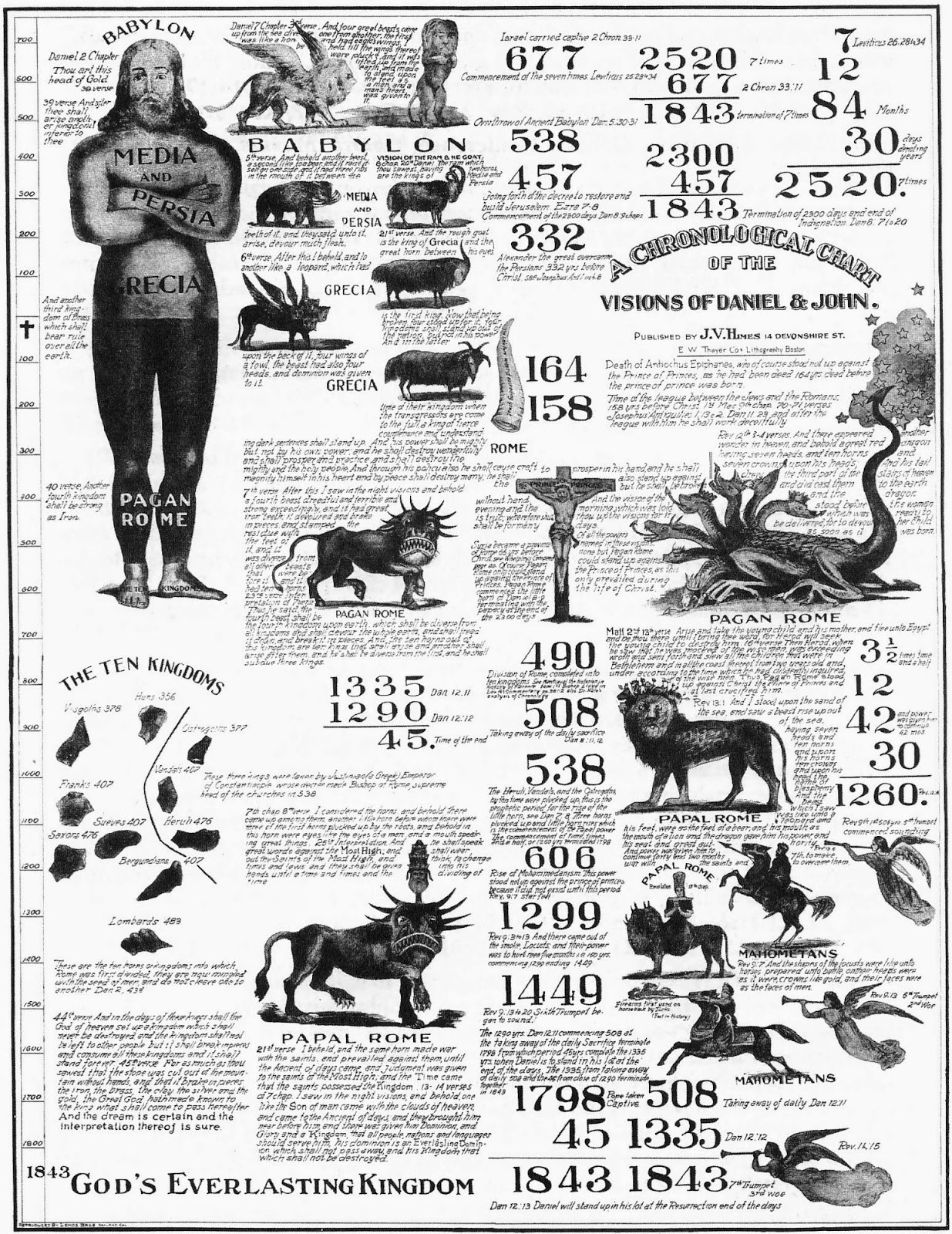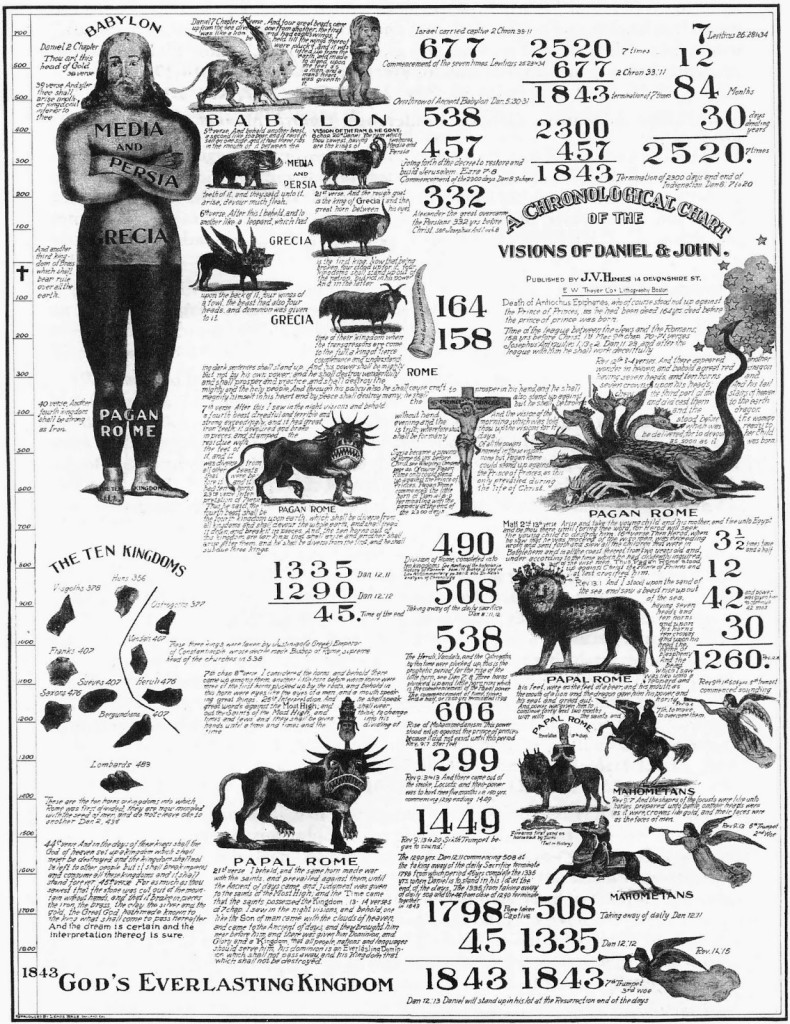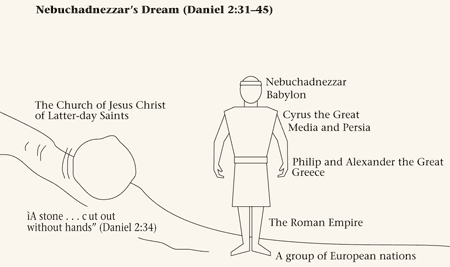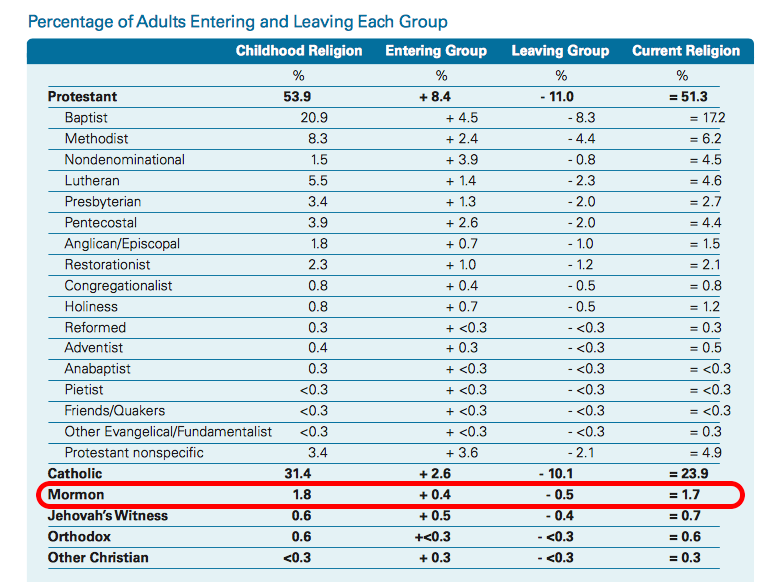“A Kingdom, Which Shall Never Be Destroyed”
Daniel 2
LDS manual: here
Reading
We’re finishing the book of Daniel today. Actually, no, we’re looking at one part of Daniel 2, the one that says, Gee, isn’t the church growing and isn’t that awesome?
There’s a whole other section that the official lesson manual isn’t going to touch. It’s Daniel’s vision of the end times. Other millennial religions love this part. Seventh-Day Adventists really go to town on it. Mormons, not so much.
The latter half of Daniel can be summed up like this:
- Angels show Daniel cryptic symbolism about the end of the world
- Daniel asks for an explanation
- The angel gives him more cryptic gobbledegook
- Daniel asks for an explanation again
- The angel tells Daniel to piss off
12:6 And one said to the man clothed in linen, which was upon the waters of the river, How long shall it be to the end of these wonders?
12:7 And I heard the man clothed in linen, which was upon the waters of the river, when he held up his right hand and his left hand unto heaven, and sware by him that liveth for ever that it shall be for a time, times, and an half; and when he shall have accomplished to scatter the power of the holy people, all these things shall be finished.
12:8 And I heard, but I understood not: then said I, O my Lord, what shall be the end of these things?
12:9 And he said, Go thy way, Daniel: for the words are closed up and sealed till the time of the end.
Daniel must have been easily impressed; I’m not. Why would a god speak in riddles like this, if his goal is to communicate his message to mankind? A god wouldn’t need to, but people who are just making stuff up would.
I used to take the end-of-the-world stuff very seriously, and wonder over what it meant. That was before I met people on my mission who took it even more seriously, and I thought they were crazy. Now, all I can think is: Isn’t it nice not to have to wonder about that silly nonsense any more? What a relief.
Main points from this lesson
How’s that stone going?
This lesson hinges on a reading of Daniel 2. King Nebuchadnezzar has had a dream. He can’t remember it, but he wants the court magicians to tell him the interpretation. They’re like, “Tell us the dream, and we’ll tell you the interpretation.” But the king’s like “Eh, if I tell you the dream, I know you’ll just make up some crap. You read my mind and tell me the dream.” He’s not so dumb.
Of course, they freak. “No one’s ever expected us to do anything like that before!” They backpedal faster than an embarrassed psychic.
Daniel, however, is able to tell the king about the dream. The king saw a big statue, representing major world kingdoms.
2:32 This image’s head was of fine gold, his breast and his arms of silver, his belly and his thighs of brass,
2:33 His legs of iron, his feet part of iron and part of clay.
There seems to be broad agreement about the kingdoms represented by the parts of the statue, except for the ten toes. People used to say it was the ten countries of the EU, but they stopped saying that when it got more than ten member nations. The lesson manual fudges it and says, “Eh. It’s Europe.”
What about before the EU? The Adventists thought it was earlier empires: the Ostrogoths, the Huns, and so forth. Check out this old chart, where it says “The Ten Kingdoms” at lower left. And look at all the Very Serious Calculations! You can tell this is the distillation of a thousand deranged notebooks.
What a farce. Interpreting prophecy is just the process of grabbing any explanation in your immediate vicinity.
Anyway, then a big stone rolls out of a mountain and knocks the image down.
2:34 Thou sawest till that a stone was cut out without hands, which smote the image upon his feet that were of iron and clay, and brake them to pieces.
So what’s the stone?
President Kimball taught: “The Church of Jesus Christ of Latter-day Saints was restored in 1830. . . . This is the kingdom, set up by the God of heaven, that would never be destroyed nor superseded, and the stone cut out of the mountain without hands that would become a great mountain and would fill the whole earth” (in Conference Report, Apr. 1976, 10; or Ensign, May 1976, 8–9).
And this is the part where Mormons trot out the fantastic stats. Here’s the chart that Mormons are seeing in Sunday School this week:
That seems impressive. And the church loves to say that it’s the fastest-growing religion.
The Church of Jesus Christ of Latter-day Saints reported an increase from 4,224,026 U.S. members in 2000 to 6,144,582 members in 2010, a 45.5 percent jump.
That is “far and away the largest gain reported by any [Christian] group,” the report noted, not just in percentage but also in actual numbers.
But don’t all religions say that?
So what’s the story here? Well, yes, the church is growing in absolute numerical terms. But there are a few things to remember.
• LDS Church population numbers, as stated, are underwhelming
Here’s a graphic that shows the percentage of Mormons v the rest of the world. Those two minuscule slivers up the top are Mormons, inactive and active ones respectively.
Not much of a stone. More like an intrusive formation. And that graph hasn’t really moved in the last 20 years.
• The church is only just keeping up
Church membership is growing, but so is the population as a whole, so the church is really just keeping pace with population.
• The church inflates its numbers
If someone simply stops going to church, it appears that they are counted as members until they’re 110 years old. Missing, presumed faithful.
• Not everyone who is counted is active.
A whoopsie moment happened this year when a church statistician let a cat out of the bag: Only 36% of members are in the pews on a given week.
“…36 attend sacrament meeting on a weekly basis”
The item was quickly redacted from the Deseret News article it appeared in, but it was saved by sharp-eyed Netizens and can be found in various locations.
Butts in seats isn’t the same as activity rates, but to the extent that they match up, thirty-six percent of 15 million equates to about 5.4 million active members worldwide.
Another way of looking at the activity issue is census records and polls. We can ask people what religion they identify as. For example, the church claims 2% of the US population, but according to a 2008 ARIS poll (PDF), only 1.4 percent of the US adult population will say they’re LDS, and that’s been holding steady for decades.
There’s an interesting angle to the ARIS numbers. Sometimes political pollsters will ask some pretty crazy questions, and we can use these to see what baseline crazy looks like.
Here are some results from Public Policy Polling. I’ve put some of these in descending order, so the beliefs get zanier the further down you go.
- 51% of voters say a larger conspiracy was at work in the JFK assassination, just 25% say Oswald acted alone
- 29% of voters believe aliens exist
- 21% of voters say a UFO crashed in Roswell, NM in 1947 and the US government covered it up. More Romney voters (27%) than Obama voters (16%) believe in a UFO coverup
- 20% of voters believe there is a link between childhood vaccines and autism, 51% do not
- 15% of voters think the medical industry and the pharmaceutical industry “invent” new diseases to make money
- 14% of voters believe in Bigfoot
- 13% of voters think Barack Obama is the anti-Christ, including 22% of Romney voters
- 9% of voters think the government adds fluoride to our water supply for sinister reasons (not just dental health)
- 7% of voters think the moon landing was faked
- 5% believe exhaust seen in the sky behind airplanes is actually chemicals sprayed by the government for sinister reasons
- 4% of voters say they believe “lizard people” control our societies by gaining political power
You can watch the beliefs get nuttier and nuttier as you go down this list. Pretty soon, we get to moon hoaxers, chemtrail believers, and finally it’s the Reptilians at 4 percent. Four percent is sort of baseline cray; it’s really difficult to crack that barrier and find a question that fewer than four percent will agree to. That could be because four percent of people will drink paint if you tell them to, or perhaps four percent of people will say yes to any question — possibly because they’re really suggestible, or they really like messing with pollsters.
But I think it’s very telling that, despite all this, you can’t get four percent of the population to admit to being a Mormon. For that question, you get a paltry 1.4 percent; less than half of what you get for Reptilians. Some people will say they believe in the Lizard People, but being a Mormon? Whoa — that’s too crazy. Isn’t that something.
• Convert baptisms slowing
There are more missionaries than ever before due to the lowering of the mission age, although this is ending as those missionaries are digested through the system. However, the church’s gains haven’t come through convert baptisms.
In the year and a half since the LDS Church lowered the minimum age for full-time missionary service, the Utah-based faith has seen its proselytizing force swell from 58,500 to more than 83,000. That’s a 42 percent leap.
The number of convert baptisms last year grew to 282,945, up from 272,330 in 2012. That’s an increase of — less than 4 percent.
Instead of converts, the church is getting its growth from the children of members. But even this is looking grim, as — like with all religions — youth are decidedly unenthusiastic about religon.
Steve Benson heard it from a friend that youth inactivity is up to 75%. (Don’t take this too seriously, even though I do take Benson seriously.)
She said that when she was a Young Women’s president, she attended a Salt Lake City-wide conference for area youth leaders. There they were shown pie charts displaying an alarming rate of youth inactivity throughout the LDS Church. She said that at the time, among the 850,000 Mormon youth in the United States, there was a whopping 75% inactivity rate, with inactivity defined as three months of non-attendance at sacrament meeting.
Conclusion
There’s your stone, rolling forth and filling the whole earth. Not very impressive. When you realise that everyone now has access to information about the church, and the church is approaching saturation — its growth peaking, baptismal rates falling — it’s looking even worse.
The Lord’s great latter-day work is a fizzle. A damp squib. The LDS Church is an insignificant sect that most people don’t care about.
Resignations up
Meanwhile, more and more of us are resigning. This Pew Forum poll from 2008 (PDF) shows that (as with many religions) more people are leaving the LDS Church than are joining it. There’s every indication that the exodus has only increased since then.
Here’s what someone asked Marlin K. Jensen of the Seventy at an LDS meeting:
A questioner asked, “Has the church seen the effects of Google on membership? It seems like the people who I talk to about church history are people who find out and leave quickly. Is the church aware of that problem? What about the people who are already leaving in droves?”
Jensen’s response:
“The fifteen men really do know, and they really care. And they realize that maybe since Kirtland, we never have had a period of, I’ll call it apostasy, like we’re having right now; largely over these issues.”
But how many are resigning? Since all we have is anecdote and hearsay, we shouldn’t take this too seriously, but Richard Packham knows someone who had the “inside scoop” on resignations. These numbers are old, but here they are.
1995:………. 35,420
1996:………. 50,177
1997:………. 55,200
1998:………. 78,750
1999:………. 81,200
2000:………. 87,500
If this trend kept going in logarithmic fashion until today (but surely hasn’t), we’d be seeing something like 120,000 people leaving a year.
It’s a good idea not to be too optimistic about resignation numbers. Obviously, the church is not going to report them. And it’s tempting for ex-Mormons to overestimate the extent of the attrition. There’s a psychological reason for this: When you leave the church, suddenly apostates seem like they’re everywhere. This could be because there really are more of us, or it could just be the availability heuristic: a thing seems more common if you can think of lots of examples of the thing, like people who have left. So a healthy sense of restraint is appropriate when approaching numbers like these.
Should you resign?
Many people I’ve talked to have no desire to write an exit letter and have their name formally removed from the records of the church. They see it as yet another hoop that the church is making them jump through, and they prefer to have nothing more to do with it. They want to leave the church on their own terms.
As for me, I decided to write my exit letter and formally resign. My reasoning: if you’re still on their records, they’re counting you, and they can use the number you represent as support for their actions, like fighting marriage equality or promoting superstition. My resignation meant I’d told them (in detail!) why I was out. They knew it. My status on the outside was the same as on the inside. For me, that meant consistency and integrity.
But there might be something eating into my small victory…
Do they still count you if you resign?
There is some debate on this, and I’ve never seen a conclusive answer. But David from Mormon Disclosures thinks they keep counting you.
Apparently, the LDS church does not appear to be subtracting resigned and excommunicated members. Also it would seem only the deaths of active members are reported to church headquarters and accounted, making its death loss much lower (3.6 in 1,000) than the actual death rate.
Thus, the additions made each year are overstated, and the subtractions are understated. This goes on year after year and the official number of members gets farther and farther from the truth.
Richard Packham has more numbers.
Official membership increased from 10,752,986 to 11,068,861 during 2000. This consists of 273,973 convert baptisms and 81,450 increase in children of record. The loss of 39,548 is due primarily to deaths, and various adjustments. The First Presidency is aware of the problem of the “name removed file” growing to hundreds of thousands of names, all still included in the 11 million. It appears that they are reluctant to change the policy, and therefore they still count those people as part of the total membership.
Others who have resigned report that church leaders somehow know about them on a ward and stake level, which would mean that some trace of their former membership is retained.
It’s hard to say what’s going on when the church is not forthcoming about its practices on stats. That’s been one of the most frustrating things about putting this lesson together — the lack of transparency means that everything is speculation. Other churches don’t operate this way. A friend of mine who was a Seventh-Day Adventist told me that they approached him and asked if he still wanted to be on the rolls. He said no, and was duly subtracted. They don’t seem too concerned about the numbers. Mormons do.
Even with all the above, I’m still an advocate for resignation. If nothing else, it’s a way to send a message to Church Headquarters, even if it goes unread and uncounted.
Additional lesson ideas
Prophecy after the fact
I only know one way to tell the future: look at the past, find patterns, and apply them to new data. If you’re using something silly, like revelation, you’ve got no better than random chance.
So how do prophets get it right sometimes? Simple — they watch what happens, and then write it down after the fact. 100% success rate!
This was a bit of a mind-blower for me as a true believing Mormon (TBM), but I got a hold of the Oxford Companion to the Bible (page 151), and found this discussion of “prophecy after the fact”.
TL;DR: The Book of Daniel predicts “the future” until a certain point, and then gets it wrong, probably because the writer was really writing about the past the whole time. Things later happened that the prophet would probably have wanted to include, but mysteriously he didn’t. Why not? Because it was in the future. He couldn’t have known; he wasn’t a prophet. No one is.
The book of Daniel is one of the few books of the Bible that can be dated with precision…. The lengthy apocalypse of Daniel 10-12 provides the best evidence for date and authorship. This great review of the political maelstrom of ancient Near Eastern politics swirling around the tiny Judean community accurately portrays history from the rise of the Persian empire down to a time somewhat after the desecration of the Jerusalem Temple and the erection there of the “abomination that makes desolate” (Dan. 11:31)…. The portrayal is expressed as prophecy about the future course of events, given by a seer in Babylonian captivity; however, the prevailing scholarly opinion is that this is mostly prophecy after the fact. Only from 11.39 onward does the historical survey cease accurately to reproduce the events known to have taken place in the latter years of the reign of Antiochus IV. The most obvious explanation for this shift is that the point of the writer’s own lifetime had been reached. Had the writer known, for example, about the success of the Jewish freedom fighters led by Judas Maccabeus in driving the garrison of the hated Antiochus from the temple precincts (an event that occurred on 25 Kislev, 164 BCE, according to 1 Macc. 4:34-31), the fact would surely have been mentioned. But evidently it had not yet happened!
Setting it to music
Here’s a bit I like because it’s connected to music.
10:18 Then there came again and touched me one like the appearance of a man, and he strengthened me,
10:19 And said, O man greatly beloved, fear not: peace be unto thee, be strong, yea, be strong.
Ralph Vaughan Williams used this bit of text from verse 19 in his Dona Nobis Pacem, first performed in the uncertainty of the inter-war years. The relevant part begins at 30:12.
I love the music on this. Daniel — or war-ravaged Europe, what have you — feels discouraged, and when the angel tells him “Be strong”, the music takes an inspiring change of key. But then it sinks back to the original key, almost as though Daniel, still despondent, is thinking “I can’t.” Then the music does the key change again: “Yea, be strong!” This is wonderful writing.
Surprisingly, the angel that spoke to Daniel had a moonlighting job as a video game minion.
10:20 Then said he, Knowest thou wherefore I come unto thee? and now will I return to fight with the prince of Persia: and when I am gone forth, lo, the prince of Grecia shall come.
Times are tough, even for angels. That does explain why minions are able to respawn round after round, though. Nice to have that mystery solved.








Recent Comments